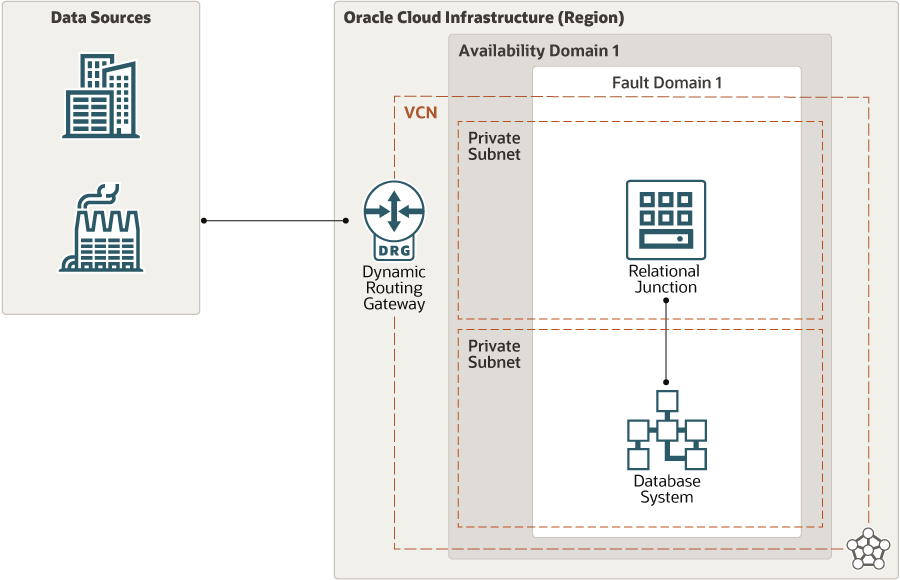Replicate data from multiple sources to a data warehouse using Relational Junction
Architecture
This architecture shows how to deploy Relational Junction by using the Oracle Cloud Infrastructure Compute service. When installed, it can replicate data from a multitude of formats and technologies.
The architecture uses a region with one availability domain and a regional subnet. The same reference architecture can be used in a region with multiple availability domains. We recommend using a regional subnet for your deployment, regardless of the number of availability domains.
The following diagram illustrates this reference architecture.

Description of the illustration architecture-deploy-relational-junction-v01.png
The architecture has the following components:
- Region
A region is a localized geographic area composed of one or more availability domains. Regions are independent of other regions, and vast distances can separate them (across countries or continents).
- Availability domains
Availability domains are standalone, independent data centers within a region. The physical resources in each availability domain are isolated from the resources in the other availability domains, which provides fault tolerance. Availability domains don’t share infrastructure such as power or cooling, or the internal availability domain network. So, a failure at one availability domain is unlikely to affect the other availability domains in the region.
- Fault domains
A fault domain is a grouping of hardware and infrastructure within an availability domain. Each availability domain has three fault domains with independent power and hardware. When you place Compute instances across multiple fault domains, applications can tolerate physical server failure, system maintenance, and many common networking and power failures inside the availability domain.
- Virtual cloud network (VCN) and subnets
A VCN is a software-defined network that you set up in an Oracle Cloud Infrastructure region. VCNs can be segmented into subnets, which can be specific to a region or to an availability domain. Both region-specific and availability domain-specific subnets can coexist in the same VCN. A subnet can be public or private.
- Security List
For each subnet, you can create security rules that specify the source, destination, and type of traffic that’s allowed in and out of the subnet.
- Relational Junction instance
This virtual component can replicate data from multiple sources to multiple targets.
- Database System
Choose a database that fits your needs, such as Oracle Autonomous Data Warehouse, Oracle Autonomous Transaction Processing, or Oracle 19c.
Recommendations
Your requirements might differ from the architecture described here. Use the following recommendations as a starting point.
- VCN
When you create the VCN, determine how many IP addresses your cloud resources in each subnet require. Using the Classless Inter-Domain Routing (CIDR) notation, specify a subnet mask and a network address range that's large enough for the required IP addresses. Use an address range that's within the standard private IP address space.
Select an address range that doesn’t overlap with your on-premises network, so that you can set up a connection between the VCN and your on-premises network, if necessary.
After you create a VCN, you can't change its address range.
When you design the subnets, consider your traffic flow and security requirements. Attach all the compute instances within the same tier or role to the same subnet, which can serve as a security boundary.
- Compute shape for Relational Junction
Use a minimum VM.Standard 2.4 shape, which you can scale up to handle larger loads.
- Use a regional subnet
Use a private subnet for both Relational Junction for the DBMS.
Considerations
- Performance
For most deployments, a VM.Standard 2.4 shape is sufficient. To decide which shape to use, look at the heaviest change set for a given cycle, which is 15 to 30 minutes for the average customer, and the number of sources you want to do in parallel. If you want high-volume traffic across more than 10 parallel runs, you can use VM.Standard2.8.
Deploy
After you provision the required networking resources as shown in this architecture, you can deploy the Relational Junction image from Oracle Cloud Marketplace:
- Go to Oracle Cloud Marketplace.
- Click Get App.
- Follow the on-screen prompts.